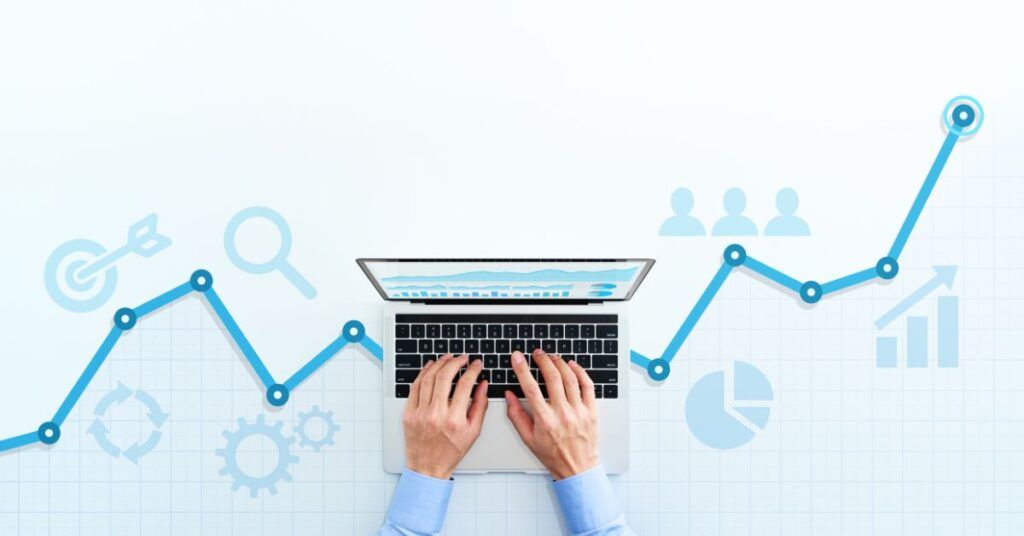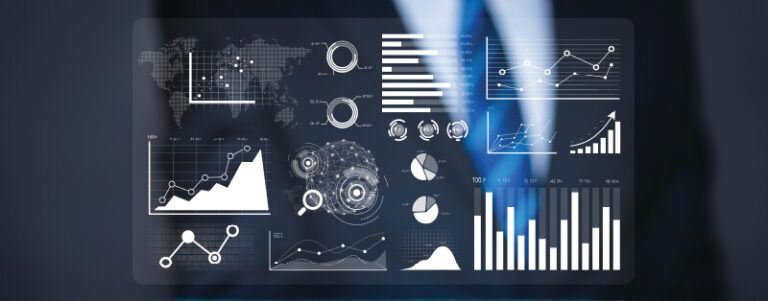Navigating the Future: Top 6 Business Analytics Trends to Watch in 2024

The landscape of Business Intelligence (BI) continues to evolve, driven by significant advancements and business analytics trends. As businesses increasingly seek customized BI solutions tailored to their specific needs, the focus shifts toward leveraging clean, secure data and powerful presentations through modern dashboard software. Furthermore, this year marks a pivotal moment for collaborative BI and AI, reshaping how data is analyzed and presented across industries. Let’s therefore take a closer look at the trends in business analytics and how they are shaping the way we do business.
Emerging Business Analytics Trends for 2024
1. Artificial Intelligence and Machine Learning

A. Integrating AI for Enhanced Insights
The integration of AI and Machine Learning (ML) into business analytics trends is gaining momentum. Companies use these technologies for predictive insights and process automation. This helps them stay competitive by anticipating market changes and customer needs. Moreover, AI algorithms enhance anomaly detection with high accuracy, promptly alerting users to unexpected events.
B. Streamlining Insights with AI
AI’s capability to upscale insights allows for automatic analysis of data sets. As a result, only select data sources and variables and get forecasts, growth trends, and what-if scenarios. The implication of this is far-reaching; there is no need for data scientists because business users can access high-quality insights easily.
C. Embracing Real-Time and Adaptive AI
The demand for real-time analytics is rising alongside the Internet of Things (IoT), which means dealing in vast amounts of data. As a result, adaptive AI systems, which adjust to real-world changes, are becoming essential for quick, informed decision-making. Furthermore, generative AI, despite its potential for bias and ethical concerns, offers significant benefits in content creation and risk management, underscoring the need for ethical implementation.
2. Data Security and Governance
A. Elevating Data Security and Governance
There is a growing emphasis on data security and governance in the realm of business trends. Moreover, as businesses collect an ever-increasing volume of data, it has become even more important to protect this information from breaches and ensure compliance with privacy regulations. Therefore, organizations are investing in robust governance frameworks and security measures to safeguard their data assets, ensuring trust and reliability in their analytics practices.
B. Understanding Data Governance in BI
Data governance is one of the pivotal business analytics trends when it comes to managing the availability, usability, integrity, and security of data used in enterprises. This ensures data is reliable, consistent, accessible, and secured, especially crucial in BI where data quality significantly impacts insights. Finally, data governance facilitates effective decision-making and regulatory compliance.
ALSO READ: 15 Key Business Analytics Tools You Can Master to Maximize Data Potential
C. Integrating Governance Tools with BI
The integration of data governance tools with BI tools is fundamental in maintaining data accuracy, reliability, and consistency. Moreover, these tools provide a framework for data quality and management, ensuring the data fed into BI tools undergoes cleansing, validation, and standardization. For instance, data governance tools standardize data from diverse sources before integration into BI systems, reducing discrepancies and augmenting analysis accuracy.
D. Practical Integration and Considerations
Integrating data governance with BI tools involves using functionalities like data cataloging, data lineage, data quality management, and ensuring data security and privacy. Moreover, this integration ensures that BI tools utilize trustworthy, high-quality data, making governance a critical component for accurate, reliable, and secure reporting. When selecting a data governance solution that integrates with BI tools, businesses should look at compatibility, scalability, security, ease of use, vendor support, and regulatory compliance.
3. Advanced-Data Discovery and Visualization
A. Elevating Business User Empowerment
Advanced data discovery and visualization tools are becoming increasingly central to making data accessible and actionable for business users. Furthermore, these tools not only facilitate the exploration of complex data sets but also enable the intuitive presentation of findings. Hence, businesses are better equipped to identify trends, opportunities, and challenges swiftly, making informed decisions with greater confidence.
B. Unlocking Insights Through Visual Analytics
Data discovery, involving the aggregation of data from various sources and its consolidation through advanced visual analytics, empowers stakeholders to analyze, manipulate, and extract actionable insights efficiently. Moreover, modern business intelligence tools, offering data integration and interactive visualizations are considered among important business analytics trends today.
C. Visualizing Data for Enhanced Decision-Making
Data visualization has now transformed into a sophisticated method of presenting and interacting with data through various graphical representations. In the business analytics trends of 2024, dashboards will further solidify their position as essential tools for visual communication, fostering collaboration by serving as the analytical nucleus of projects. As a result, with the integration of AI-based alarms and real-time data, KPI dashboards will advance interactivity features, enhancing their utility.
ALSO READ: How to Become a Business Analyst and What Skills are Needed?
4. Sustainable Data and Analytics Practices

A. Integrating Sustainability With Business Analytics
The latest business analytics trends increasingly focus on sustainability. Companies are now leveraging analytics not only for economic gain but also to advance their Environmental, Social, and Governance (ESG) initiatives. Consequently, this shift toward sustainable data and analytics practices demonstrates a commitment to responsible business operations and long-term value creation, reflecting broader societal and environmental concerns.
B. The Evolving Role of Data and Analytics in Sustainability
As climate change remains a global concern, businesses across all sizes and industries are recognizing the hidden potential of sustainability. Moreover, they are using data and analytics to enhance their strategies and optimize efforts, tracking critical metrics such as energy consumption, gas emissions, and supply chain performance. Consequently, this approach allows organizations to extract valuable insights to guide their sustainability journey, aligning with analytics trends.
C. Anticipating Change With Sustainable Analytics
In 2024 and beyond, organizations are expected to use D&A sustainability to anticipate changes in demand, adjust resource usage, and make financially intelligent decisions. Besides resource-related data, factors like production levels, sales volume, employee headcounts, and even weather data will facilitate real-time decision-making.
D. Ensuring Comprehensive Engagement and Compliance
Ensuring that all employees and stakeholders are involved in sustainability efforts is essential. Training initiatives to engage employees with the process are a good starting point. Furthermore, linking ESG initiatives to business outcomes encompasses compliance with laws, tracking ESG goal performance, and uncovering new operational sustainability opportunities. This is one of the growing business analytics trends that underscores the integration of sustainability into operations as a critical element for business success in 2024 and beyond.
ALSO READ: What is Predictive Analytics and How it Helps Business Grow
5. Collaborative Business Intelligence
A. Transforming Decision-Making With Collaborative BI
The trend toward collaborative environments in BI tools is revolutionizing decision-making across organizations. Furthermore, these tools promote seamless sharing and communication among teams, thus breaking down silos and fostering a data-driven culture. Consequently, businesses can leverage collective insights to effectively navigate complex landscapes, marking a significant business analytics trend.
B. The Rise of Data Sharing
Data has become a critical asset for competitive advantage. Business analytics trends focusing on efficient data sharing are set to outperform in value metrics. Importantly, shifting from a “don’t share data unless necessary” to a “must share data unless…” mindset is crucial for aligning analytics with overarching business trends, enabling agile and informed decision-making.
C. Self-Service BI for Greater Collaboration
Self-service BI tools are enhancing collaboration by enabling easy access to data and insights without IT dependency. Importantly, these tools support automated reports and interactive dashboards across devices, which is crucial for adapting to remote work and maintaining effective decision-making workflows.
D. The Evolution of Data Sharing and Collaboration
By 2024, data sharing is expected to integrate deeply into the analytical workflow, involving all stakeholders and addressing security concerns with a collaborative BI approach. Hence, this evolution points toward a unified analytics environment, overcoming the challenges of siloed functions and paving the way for a more collaborative and productive future in business intelligence.
ALSO READ: Business Intelligence vs. Business Analytics: Key Differences
6. Continuous Intelligence and Real-Time Analytics
A. Embracing Continuous Intelligence
The demand for continuous intelligence and real-time analytics is one of the key business analytics trends. In today’s business climate, instant responses with data-driven insights are crucial. Thus, organizations are adopting technologies that facilitate continuous and real-time analytics, remaining agile amidst evolving market dynamics. This movement underscores a significant shift in business analytics trends.
B. Understanding Continuous Intelligence (CI)
Continuous Intelligence (CI), as defined by Gartner, integrates real-time analytics directly into business operations. Furthermore, this approach automates insight extraction from vast data volumes, offering a seamless flow of real-time insights. CI revolutionizes analytics trends by transitioning from static metrics to dynamic, real-time analysis, enhancing businesses’ ability to identify trends and anomalies swiftly.
C. Real-Time and Historical Data Synergy
CI leverages both real-time and historical data, allowing businesses to make informed decisions promptly. For example, a manufacturing entity can detect potential machine failures in real time and use historical data for comprehensive insights, streamlining decision-making. Therefore, this blend of data enriches the analytics landscape, aligning with emerging business trends.
D. Future Outlook on CI
Businesses leverage CI to optimize operations, replacing manual analysis and speeding insights using AI and ML algorithms. As a result, the transition to CI in 2024 signifies a broader adoption of AI-driven, real-time analytics, transforming business intelligence practices.
ALSO READ: A Guide to Business Analysis: 7 Skills to Boost Your Analytics Career
In conclusion, 2024’s business analytics trends are set to revolutionize strategic decision-making, thus emphasizing AI and ML, data security, and sustainable practices. They underscore the value of collaborative BI tools and real-time analytics in a competitive landscape. To stay on top of these trends, therefore, professionals need to keep learning and upgrading themselves. To that end, Emeritus’ business analytics courses equip individuals for success in this evolving field, highlighting the importance of adopting these trends for business growth and innovation.
Write to us at content@emeritus.org




